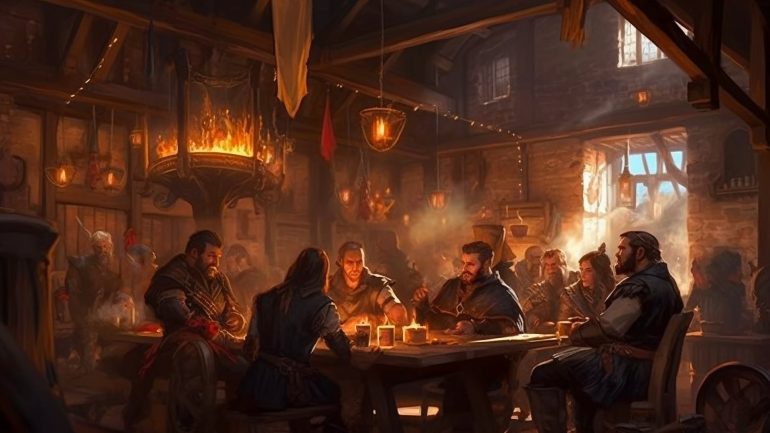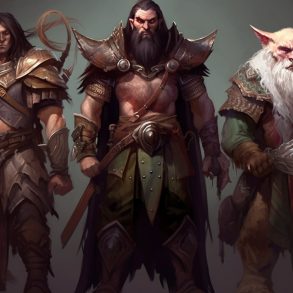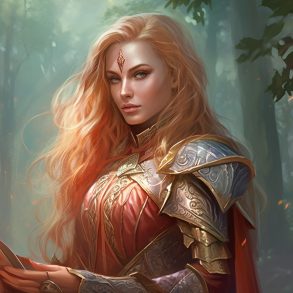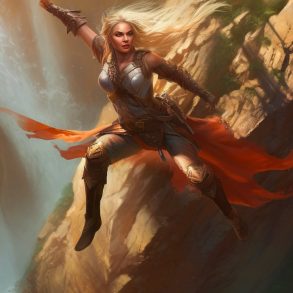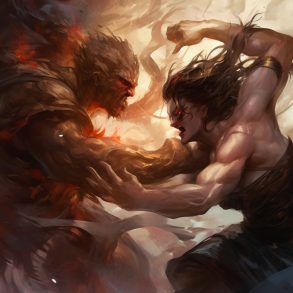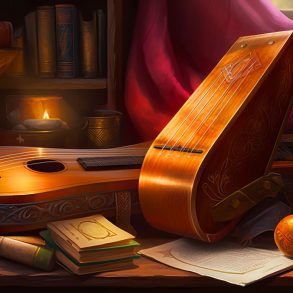Roleplaying is an essential part of Dungeons & Dragons and always has been. The freedom to choose your own character and handcraft them from scratch with love and care has always been an attractive feature to the game.
In 5th Edition DnD, not only can any player create fantastic backgrounds filled with rich flavor text for their characters, but these backgrounds also come with added mechanical bonuses called “Proficiencies.” In the advanced 5E tools, there are many different background options to choose from that can make character customization more detailed and specific. However, this list could appear to be more daunting for new players.
In DnD Beyond, the official list is narrowed down to just six options, making this structure easier for introducing new players to the game and helping them feel more comfortable in their character creation; it also leaves enough freedom for a more experienced player to mix and match parts of different pre-sets, allowing for more customization of a character.
Why bother with a background?
In addition to making character creation and roleplaying smoother and more fun for all party members, your chosen background will influence gameplay. Each background provides two Skill Proficiencies, Language, and Equipment bonuses to the character. Proficiencies are tied into character creation from the beginning, and players will have the chance to add more Proficiency bonuses as they play through the campaign and level up.
If you are interested in learning more about leveling bonuses and things that more heavily influence mechanics, take a look at this article on Feats. It allows for more long-term planning for your character concept by giving them unique mechanical bonuses and twists that you can fit in with your choice of background.
It’s important to keep backgrounds in mind so players can choose bonuses that will make sense for their character’s backstory, as well as provide the most benefit to their party. I won’t get into Language and Equipment bonuses here as they deserve articles all their own, but I’ve included a table that shows skill bonuses per major background. Always remember to plan your backgrounds and characters with the help of your DM!
| Background | Skill Proficiencies | Notes – Skill | |
|---|---|---|---|
| Acolyte | Insight | Religion | Wisdom and Intelligence |
| Criminal | Deception | Stealth | Charisma and Dexterity |
| Folk Hero | Animal Handling | Survival | Wisdom |
| Noble | History | Persuasion | Intelligence and Charisma |
| Sage | Arcana | History | Intelligence |
| Soldier | Athletics | Intimidation | Strength and Charisma |
Who should you be and why?
Using the DnD Beyond guide is a great place to start for beginning the character creation process. However, it takes a little creativity to truly craft the ideal character for the campaign; you and your DM can work to add additional flavor to any of these backgrounds or modify them to make sense for the story as needed. The following sections break down each main pre-set with descriptions on what they are and suggestions on how they can be tweaked to better suit your character. Keep in mind these come from the Beyond Player’s Handbook. There are still other official backgrounds you can choose from in content like Innistrad and Eberron.
Acolyte
An Acolyte is someone who spent part of their life in service to a chosen deity, often secluded in a temple dedicated to that god. Typically, an Acolyte would perform sacred rituals and act as an intermediary between their deity and the Mortal Plane. Clerics and Paladins were most likely Acolytes at some point, but you can build a background however you choose. In fact, an Acolyte doesn’t have to be solely good. Perhaps your character was part of a cult that worshiped evil or demonic gods instead! Choosing this Background will allow you and your companions to receive help and care from other followers of your faith, particularly from related temples (provided you left them on good terms). This could be helpful in finding a cheap place to stay, or healing from a recent fight.
Criminal
There are several different types of Criminal Backgrounds that are most commonly associated with Rogues. The most common are Assassins and Thieves, but there are plenty of other ways to twist this to suit your character. Perhaps your Criminal has more of a Good alignment, working as a hired Spy! Or maybe they grew up as a street urchin, fighting every day to survive. DnD Beyond offers several suggested Specialties for this Background as well, such as Blackmailer, Burglar, and Fence. Choosing the Criminal background can aid your party by offering a decent network of communication in the underground, allowing you to send and receive letters more easily. Adding further bonuses to Deception and Perception could also make it easier to Bribe officials or detect corruption in a local merchant.
Folk Hero
Folk Heroes are one of the most well-known classic fantasy tropes out there. Think Farmboy-Turned-Savior à la Rand Al’Thor, Frodo Baggins, Eragon; the list goes on and on. This character archetype is near and dear to many fantasy-lovers, which is why it is so pervasive in the genre. Despite its simplicity, it is still quite a common background choice in DnD players. There isn’t as much you can customize; you could choose the original occupation such as shepherd, farmer, or miner, but a certain allure lies in those simple roots. This character is a hero with humble beginnings and so the common people love and accept them everywhere they go. Commoners will help you and your party where they can, even going as far as hiding you from the local law!
Noble
Have you always wanted to be rich and powerful? This background gives you the opportunity to make a character that is wealthy and privileged, offering some useful bonuses to your party thanks to having an important name. If the life of a spoiled Noble isn’t as enticing, perhaps your character was disowned by their family instead? A disgraced name and title isn’t worth nearly as much, but it could lead to some very interesting interactions and quests in the campaign.
It’s a particularly good idea to work closely with your DM when choosing this background, as it will help them to decide on allowances for your nobility within the world they’ve chosen (or created). If you choose to remain a Noble in good standing, this can help your party secure meetings with other local lords and potentially aid in quest advancement.
Sage
The wise old Sage is another classic trope in fantasy literature that sees a lot of use in the modern day. This background is for players that want their character to be reminiscent of Moiraine, Gandolf, Brom, etc. Of course, your character doesn’t have to be extremely old! Sages have spent years studying all sorts of subjects that interest them, making them masters in their chosen fields of study. This background is especially useful to magic users like Wizards that utilize Intelligence (Arcana). Sages can be beneficial to the party as a source of knowledge. If your character doesn’t know certain information, they will at least know where to find it.
Soldier
This background is somewhat versatile. A Soldier has spent their life, often trained from birth, fighting for one faction or another. A player will have the option to make this a good- or evil-aligned character by choosing whether they fought in a standing army or if they worked for a mercenary company, or anything else you might come up with. However, the player will have to work with the DM to make sure this background aligns with the lore of the campaign. If the player chooses this background and opts to have their character be a decorated and respected soldier, this can come with additional perks for the party; such as commanding respect from soldiers of lower rank or even requisitioning horses for travel! The party can also gain access to military encampments and fortresses, so long as they are part of a friendly faction.
Homebrew background alternatives
If the 6 pre-set options for official DnD don’t really work for you, there is always the option to choose from a set of alternative Homebrew backgrounds (make sure you clear this with your DM, of course).
If you want suggestions for sample backgrounds that cater more specifically to a particular class, you can check out my recommendations in the list below:
- Outlander for Barbarians
- Entertainer for Bards
- Faction Agent for Clerics
- Hermit for Druids
- Urchin for Fighters
- Far Traveler for Monks
- City Watch for Paladins
- Urban Bounty Hunter for Rangers
- Charlatan for Rogues
- Inheritor for Sorcerers
- Haunted One for Warlocks
- Guild Artisan for Wizards
How to begin your background
Character creation is a complex but entertaining part of DnD. Getting started for the first time can be daunting!
Many experienced players enjoy the aspect of character creation more than any other part of a new campaign. Regardless if you’re new to the game or just stuck, choosing a proper background for your character can be decided by asking yourself a few questions.
- Do I want my character to be good or bad?
- Do I want them to use magic?
- Should they come from humble beginnings?
Sometimes it’s easiest to pick a race and class first, then mold a background around the character; you could also ask your DM and fellow players what role(s) the party could use. If you’re getting really stuck, try assigning a numerical value to each character option and let the roll of the die decide who and what your character is. The DnD Beyond guide makes character creation a breeze! They even include a list of typical personality traits seen in certain backgrounds, making it as simple as possible to make a rich and intriguing character. If you don’t want to utilize their lists, you can always turn to your favorite fantasy characters for inspiration as well. Just remember to have fun with it!
